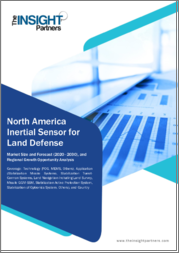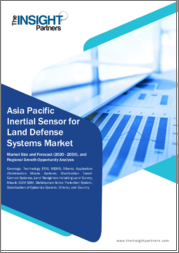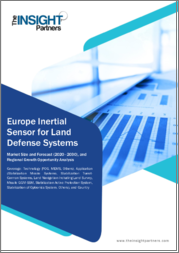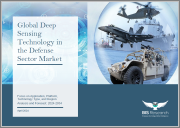
|
시장보고서
상품코드
1406025
군용 센서 : 시장 점유율 분석, 산업 동향과 통계, 성장 예측(2024-2029년)Military Sensors - Market Share Analysis, Industry Trends & Statistics, Growth Forecasts 2024 - 2029 |
||||||
군용 센서 시장 규모는 2024년에 157억 6,000만 달러로 추정되며, 2029년에는 212억 5,000만 달러에 달하며, 예측 기간(2024-2029년) CAGR로 6.16%의 성장이 예측됩니다.
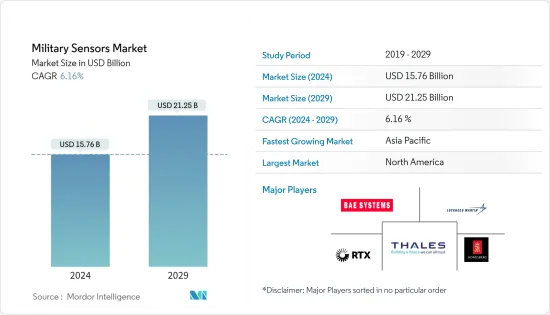
미세전자기계시스템(MEMS) 기반 디바이스의 발전과 급속한 채택으로 내비게이션 및 포지셔닝을 위한 고급 마이크로 자이로, 적외선 이미징을 위한 마이크로보로미터, 레이저 빔 조향을 위한 마이크로 미러 등이 개발되고 있으며, RF MEMS 및 나노기술은 100GHz 이상의 속도에서 위성 통신과 진정한 시간 지연을 실현하는 전자식 조향이 가능한 RF 위상 시프터와 같은 항공우주 및 국방 용도에 획기적인 발전을 가져올 수 있습니다.
현대 군 시스템은 임무를 수행하기 위해 복잡한 소프트웨어와 상호 연결성에 크게 의존하고 있습니다. 사이버 대응 군 시스템의 전자 공격, 센서 융합 및 통신과 같은 고급 기능은 적대 세력에 대한 또는 적대적인 환경에서 중요한 작전 중에 장비된 군에 전술적 우위를 제공합니다. 방위군의 전장 인식에 대한 수요 증가, MEMS 기술의 발전, 내비게이션 시스템과의 항재밍 기능 통합 등의 요인이 시장 성장을 촉진하고 있습니다. 그러나 사이버 보안 위험, 군용 센서 설계의 복잡성, 낮은 정확도 등이 시장 성장을 저해하는 요인으로 작용하고 있습니다.
군용 센서 시장 동향
예측 기간 중 공수 부문이 가장 높은 CAGR로 성장할 것으로 예상
현대 군용 항공기는 다양한 임무를 수행할 수 있도록 만들어졌습니다. 전 세계 항공기 증가로 인해 공수 부문의 군용 센서에 대한 수요가 증가하고 있습니다. 미국, 인도, 중국, 이란, 이스라엘, 러시아와 같은 국가들은 기존 항공대의 현대화 및 업그레이드에 투자하고 있습니다. 중국은 무인 플랫폼에 스텔스 기술을 사용하고 더 많은 UAV 변형을 출시하고 있습니다. 또한 세계 각국의 국방력 강화를 위한 지출 증가가 시장 성장의 원동력이 되고 있습니다.
또한 유인 플랫폼에 비해 무인 플랫폼의 비용 효율성과 운영의 용이성은 감시 및 공격 작전 등 국방 분야에서 UAV의 빠른 보급을 촉진하고 있습니다. 군 조직도 전 세계 분쟁 지역에 무인 플랫폼을 대규모로 배치하고 있습니다.
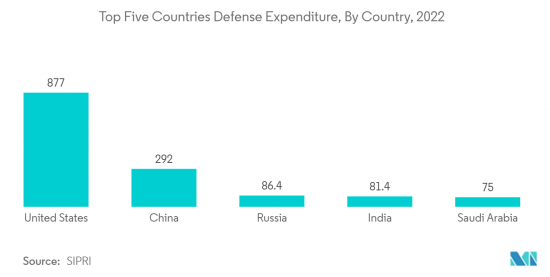
예측 기간 중 아시아태평양이 가장 높은 수요를 창출할 것으로 예상
아시아태평양은 예측 기간 중 지역 방위력 현대화를 촉진하는 여러 진행 중인 프로그램을 이유로 군 센서에 대한 가장 높은 수요를 창출할 것으로 예상됩니다. 예를 들어 인도네시아 국방부는 터키와 3억 달러 상당의 최신형 무인 항공기 12대를 구매하는 계약을 체결하여 노후화된 군의 현대화를 위한 지속적인 노력의 새로운 단계를 밟았습니다. 이 지역은 항공기 및 회전익 항공기를 가장 많이 보유한 지역으로 14,529대의 항공기를 보유하고 있습니다. 이 중 전투기는 약 4,998대, 특수목적기 520대, 유조선 46대, 운송기 1,008대, 훈련용 헬리콥터 3,079대 등입니다. 주변국 간의 지정학적 긴장이 고조되고 첨단 위협 탐지 시스템에 대한 수요가 증가함에 따라 이 지역 시장 성장이 촉진될 것으로 예상됩니다.
군용 센서 산업 개요
군용 센서 시장은 반통합형 시장으로 많은 유명 업체들이 더 큰 시장 점유율을 차지하기 위해 경쟁하는 것이 특징입니다. RTX Corporation, Lockheed Martin Corporation, Kongsberg Gruppen ASA, BAE Systems plc, THALES 등이 군용 센서 시장의 주요 업체로 꼽힙니다. 공급업체들은 최종사용자에게 부가가치가 높은 센서 솔루션을 제공하기 위한 수단으로 현재 기능을 강화하고 획기적인 기능을 도입하기 위해 제품을 변경하고 있습니다. 이는 차별성이 낮은 제품을 경쟁력 있는 가격으로 도입하는 데 도움이 됩니다. 또한 최종사용자인 방위군의 설계 및 성능 사양에 부합하는 고급 센서를 개발하기 위해 제조업체 간의 전략적 협력이 증가하고 있습니다. 이는 예측 기간 중 업계 이해 관계자들에게 혜택을 줄 것으로 예상됩니다.
기타 특전
- 엑셀 형식의 시장 예측(ME) 시트
- 3개월간의 애널리스트 지원
목차
제1장 서론
- 조사의 전제조건
- 조사 범위
제2장 조사 방법
제3장 주요 요약
제4장 시장 역학
- 시장 개요
- 시장 촉진요인
- 시장 억제요인
- Porter's Five Forces 분석
- 공급 기업의 교섭력
- 구매자·소비자의 교섭력
- 신규 진출업체의 위협
- 대체품의 위협
- 경쟁 기업간 경쟁 강도
제5장 시장 세분화
- 애플리케이션
- 정보·감시·정찰(ISR)
- 통신·내비게이션
- 타깃 인식
- 전자전
- 지휘 통제
- 플랫폼
- 공정
- 육상
- 해상
- 지역
- 북미
- 미국
- 캐나다
- 유럽
- 영국
- 프랑스
- 이탈리아
- 러시아
- 독일
- 기타 유럽
- 아시아태평양
- 중국
- 일본
- 인도
- 한국
- 기타 아시아태평양
- 라틴아메리카
- 브라질
- 멕시코
- 기타 라틴아메리카
- 중동 및 아프리카
- 사우디아라비아
- 아랍에미리트
- 남아프리카공화국
- 기타 중동 및 아프리카
- 북미
제6장 경쟁 구도
- 벤더 시장 점유율
- 기업 개요
- Honeywell International Inc.
- TE Connectivity Ltd.
- RTX Corporation
- Lockheed Martin Corporation
- THALES
- Kongsberg Gruppen ASA
- Ultra
- Aerosonic LLC(Transdigm Group)
- General Electric Company
- BAE Systems plc
- Vectornav Technologies LLC
- Viooa Imaging Technology Inc.
- Imperx Inc.
제7장 시장 기회 및 향후 전망
KSA 24.01.19
The Military Sensors Market size is estimated at USD 15.76 billion in 2024, and is expected to reach USD 21.25 billion by 2029, growing at a CAGR of 6.16% during the forecast period (2024-2029).
The evolution and rapid adoption of microelectromechanical systems (MEMS)-based devices have led to the development of sophisticated micro gyros for navigation and positioning, microbolometers for infrared imaging, and micromirrors for steering laser beams. RF MEMS and nanotechnology could lead to breakthroughs in aerospace and defense applications, such as satellite communications at speeds in excess of 100 GHz and electronically steerable RF phase shifters for true-time delay.
Modern military systems are heavily reliant on complex software and interconnectivity to perform their missions. Advanced features, such as an electronic attack, sensor fusion, and communications, of the cyber-enabled military systems provide a tactical edge to the equipped armed forces against an adversary force or during critical operations in a hostile environment. Factors such as increasing demand for battlespace awareness amongst defense forces, ongoing advancements in MEMS technology, and integration of anti-jamming capabilities with navigation systems will be driving the growth of the market. However, cybersecurity risks, complexity in the designs of military sensors, and lack of accuracy would be constraining the growth of the market.
Military Sensors Market Trends
Airborne Segment Expected to Register the Highest CAGR During the Forecast Period
Modern military planes are made to do different kinds of missions. An increase in the global aerial fleet has led to a rise in the demand for military sensors in airborne segments. Countries like the United States, India, China, Iran, Israel, and Russia, among others, have invested in modernizing and upgrading their existing air fleets. China is using stealth technology in unmanned platforms and is unveiling more UAV variants. Furthermore, rising global expenditure and rising spending on enhancing defense capabilities drive market growth.
Moreover, the cost-effectiveness and ease of operations of unmanned platforms, compared to manned platforms, aided the rapid adoption of UAVs in defense applications (for both surveillance and attack operations). Military organizations are also largely deploying unmanned platforms in conflict regions across the world. Also instances such as in September 2022, the US Army awarded phase two contracts to defense firms Raytheon and L3Harris for the development of prototype sensors that were to support the service's next-gen airborne intelligence, surveillance, and reconnaissance program dubbed HADES. These factors render a positive outlook for the airborne military sensors segment of the market during the forecast period.

Asia-Pacific is Expected to Generate the Highest Demand During the Forecast Period
The Asia-Pacific region is expected to generate the highest demand for military sensors on account of the several ongoing programs fostering the modernization of the regional defense forces during the forecast period. In the Asia-Pacific, several modernization programs are underway to enhance the current capabilities of the commercial and military end-users in the region. For instance, Indonesia's Defence Ministry sealed a deal with Turkey to acquire 12 cutting-edge drones valued at USD 300 million, marking yet another step in the country's ongoing efforts to modernize its aging military equipment. In terms of operational fleet, the region has the largest fleet of aircraft and rotorcraft, with 14,529 aircraft. Out of these, combat aircraft constitute about 4,998, along with 520 special purpose aircraft, 46 tankers, 1,008 transport, and 3,079 training and helicopters. The increasing geopolitical tensions between neighboring nations and the rising demand for advanced threat detection systems are expected to aid the growth of the market in this region.
Military Sensors Industry Overview
The military sensors market is semi-consolidated and marked by the presence of many prominent players competing for a larger market share. The prominent players in the military sensors market are RTX Corporation, Lockheed Martin Corporation, Kongsberg Gruppen ASA, BAE Systems plc, and THALES. Vendors are modifying their offerings to enhance current capabilities and introduce revolutionary features as a means to deliver value-added sensor solutions to end users. This helps introduce low-differentiated products at competitive pricing. Furthermore, strategic collaboration between manufacturers is on the rise to develop sophisticated sensors that conform with the design and performance specifications of the end-user defense forces. This is expected to benefit industry stakeholders during the forecast period.
Additional Benefits:
- The market estimate (ME) sheet in Excel format
- 3 months of analyst support
TABLE OF CONTENTS
1 INTRODUCTION
- 1.1 Study Assumptions
- 1.2 Scope of the Study
2 RESEARCH METHODOLOGY
3 EXECUTIVE SUMMARY
4 MARKET DYNAMICS
- 4.1 Market Overview
- 4.2 Market Drivers
- 4.3 Market Restraints
- 4.4 Porter's Five Forces Analysis
- 4.4.1 Bargaining Power of Suppliers
- 4.4.2 Bargaining Power of Buyers/Consumers
- 4.4.3 Threat of New Entrants
- 4.4.4 Threat of Substitute Products
- 4.4.5 Intensity of Competitive Rivalry
5 MARKET SEGMENTATION
- 5.1 Application
- 5.1.1 Intelligence, Surveillance, and Reconnaissance (ISR)
- 5.1.2 Communication and Navigation
- 5.1.3 Target Recognition
- 5.1.4 Electronic Warfare
- 5.1.5 Command and Control
- 5.2 Platform
- 5.2.1 Airborne
- 5.2.2 Terrestrial
- 5.2.3 Naval
- 5.3 Geography
- 5.3.1 North America
- 5.3.1.1 United States
- 5.3.1.2 Canada
- 5.3.2 Europe
- 5.3.2.1 United Kingdom
- 5.3.2.2 France
- 5.3.2.3 Italy
- 5.3.2.4 Russia
- 5.3.2.5 Germany
- 5.3.2.6 Rest of Europe
- 5.3.3 Asia-Pacific
- 5.3.3.1 China
- 5.3.3.2 Japan
- 5.3.3.3 India
- 5.3.3.4 South Korea
- 5.3.3.5 Rest of Asia-Pacific
- 5.3.4 Latin America
- 5.3.4.1 Brazil
- 5.3.4.2 Mexico
- 5.3.4.3 Rest of Latin America
- 5.3.5 Middle East and Africa
- 5.3.5.1 Saudi Arabia
- 5.3.5.2 United Arab Emirates
- 5.3.5.3 South Africa
- 5.3.5.4 Rest of Middle East and Africa
- 5.3.1 North America
6 COMPETITIVE LANDSCAPE
- 6.1 Vendor Market Share
- 6.2 Company Profiles
- 6.2.1 Honeywell International Inc.
- 6.2.2 TE Connectivity Ltd.
- 6.2.3 RTX Corporation
- 6.2.4 Lockheed Martin Corporation
- 6.2.5 THALES
- 6.2.6 Kongsberg Gruppen ASA
- 6.2.7 Ultra
- 6.2.8 Aerosonic LLC (Transdigm Group)
- 6.2.9 General Electric Company
- 6.2.10 BAE Systems plc
- 6.2.11 Vectornav Technologies LLC
- 6.2.12 Viooa Imaging Technology Inc.
- 6.2.13 Imperx Inc.








